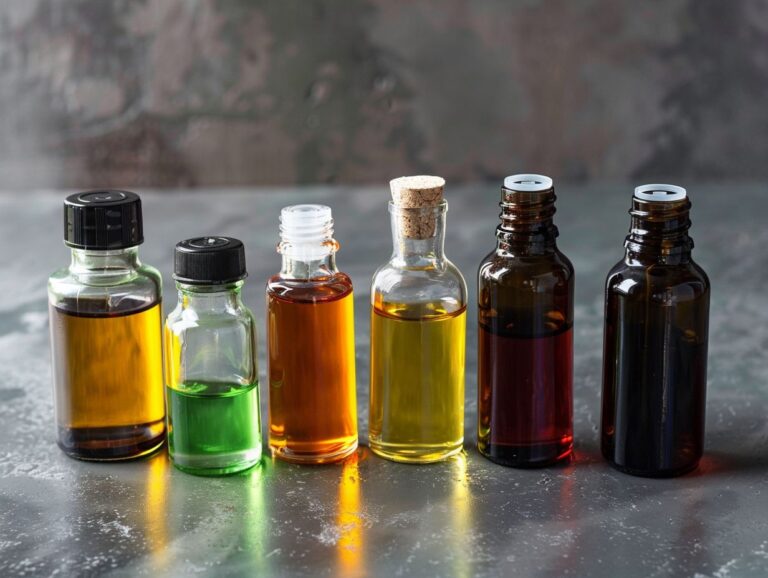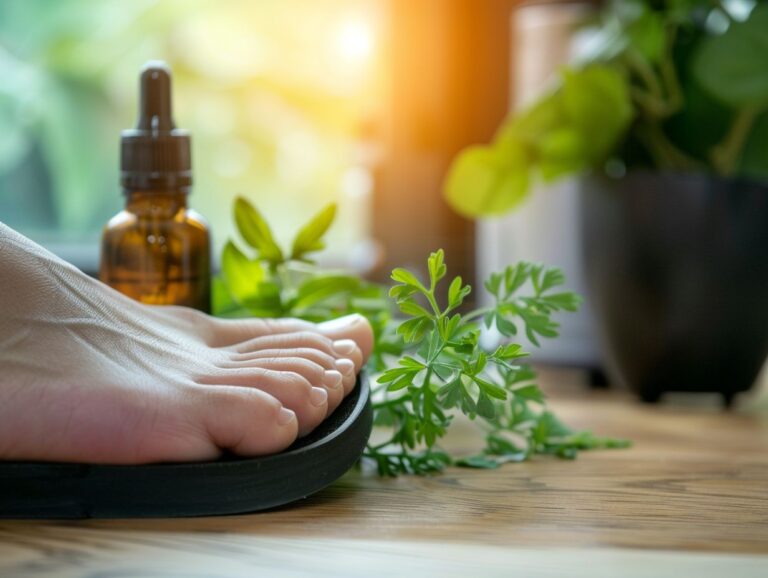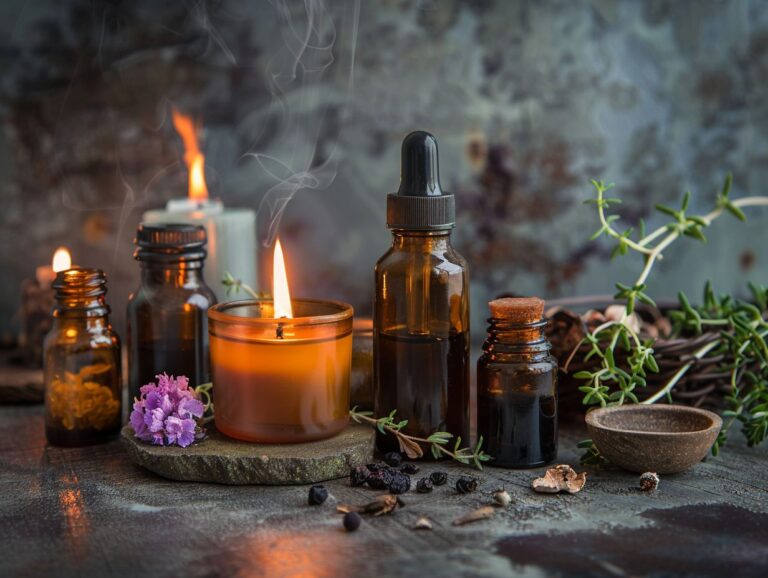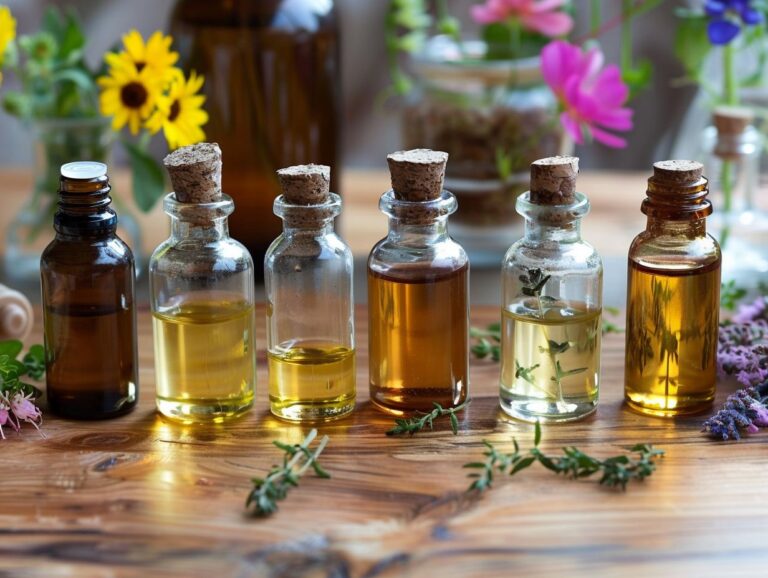How Toxic Are Essential Oils
Essential oils have gained popularity in recent years for their various uses, from aromatherapy to skincare and even cleaning products. But are these potent oils safe to use?
We will explore the process of making essential oils, their common uses, and whether or not they can be toxic. We will also discuss potential side effects and how to use essential oils safely.
Discover alternative options to essential oils for those seeking natural remedies. Learn how to effectively and safely incorporate essential oils into your daily routine.
Key Takeaways:
What Are Essential Oils?
Essential oils are concentrated plant extracts that capture the essence of the plant’s fragrance and properties. They are derived through processes like distillation or cold pressing from various plant parts such as leaves, flowers, or roots.
These extraction methods are chosen based on the plant material and the desired oil. For instance, steam distillation is commonly used for extracting oils from flowers and leaves, while cold pressing is preferred for citrus fruits.
The chemical composition of essential oils varies depending on the plant species, but they typically contain volatile aromatic compounds like terpenes, alcohols, esters, and phenols. Learn more about why essential oils are harmful.
Essential oils are utilized in diverse industries such as aromatherapy, cosmetics, food flavoring, and even cleaning products due to their therapeutic, fragrance, and antimicrobial properties.
How Are Essential Oils Made?
The process of making essential oils involves extracting the aromatic compounds from plants through methods such as steam distillation, solvent extraction, or cold pressing. The chemical composition of essential oils includes alcohols, aldehydes, esters, ketones, phenols, and terpenes.
Alcohols, such as Linalool and Geraniol, provide pleasant floral scents commonly found in essential oils.
Aldehydes, like Citral and Cinnamaldehyde, offer citrusy and spicy notes.
Esters, such as Linalyl Acetate, contribute to the fruity and sweet aroma of certain oils.
Ketones, such as Camphor and Thujone, possess strong therapeutic properties but need to be used cautiously due to their potential toxicity.
Phenols, like Eugenol and Thymol, exhibit antibacterial and antifungal characteristics, making them valuable in natural remedies.
Terpenes, the largest group of compounds in essential oils, consist of monoterpenes and sesquiterpenes that provide a wide range of fragrances and therapeutic benefits.
What Are the Uses of Essential Oils?
Essential oils find applications in aromatherapy for relaxation and well-being, skincare for their beneficial properties, and as natural ingredients in cleaning products for their antimicrobial and aromatic qualities.
In aromatherapy, essential oils are used in diffusers or massage oils to create a calming atmosphere or relieve stress. These oils are known for their mood-boosting and stress-relieving benefits. In skincare routines, they can target specific skin concerns such as acne, aging, or dryness due to their anti-inflammatory and antioxidant properties.
Regarding household cleaning, essential oils like tea tree, lavender, or eucalyptus are popular choices for their germ-fighting and refreshing scents. Their natural antibacterial properties make them effective alternatives to chemical-laden cleaning products.
Aromatherapy
Aromatherapy involves using essential oils to promote relaxation, reduce stress, and improve mood through inhalation or topical application.
Essential oils are derived from plants and possess powerful properties that can benefit both the mind and body. These oils are known for their ability to relieve anxiety, improve sleep quality, and even boost energy levels. One of the primary benefits of aromatherapy is its ability to enhance emotional well-being, making it a popular choice in holistic healing practices.
When using essential oils, it’s important to understand the different methods of application. Inhalation, whether through a diffuser or by simply inhaling the scent directly from the bottle, can help calm the mind and alleviate stress. Topical application, when diluted with a carrier oil, allows for absorption through the skin, offering targeted relief for aches and pains.
Skincare
Essential oils are incorporated into skincare products for their moisturizing, soothing, and rejuvenating effects on the skin. Improper use may lead to skin irritation in some individuals.
It’s important to understand that essential oils are highly concentrated and potent extracts from plants that can either enhance your skincare routine or potentially cause adverse reactions if not used correctly. Patch testing a small amount of diluted oil on a small area of skin before full application can help identify any sensitivities or allergies. Some essential oils are photosensitive, meaning they can make your skin more sensitive to sunlight, so using them at night may be beneficial. As with any skincare product, moderation and caution are key to enjoying the benefits of essential oils without any negative consequences.
Cleaning Products
Essential oils are included in cleaning products for their natural antimicrobial properties and pleasant fragrances, offering an eco-friendly alternative to conventional chemical-based cleaners.
These potent oils derived from plant extracts have been used for centuries in various cultures for their cleaning and disinfecting abilities. Not only do essential oils effectively kill bacteria and germs, but they also leave behind a refreshing scent, devoid of harsh chemical residues. The versatility of essential oils allows them to be mixed with other natural ingredients like vinegar and baking soda to create powerful all-purpose cleaners that can tackle dirt and grime in every corner of your home.
Are Essential Oils Toxic?

While essential oils are widely used in aromatherapy and natural skincare, their concentrated nature means that they pose risks if not used appropriately. Ingesting essential oils can be particularly dangerous as they can irritate the mucous membranes, cause stomach upset, and in severe cases, lead to organ damage. Some essential oils contain compounds that are toxic when metabolized by the body, potentially causing liver or kidney damage. It’s important to always dilute essential oils properly and seek guidance from a healthcare professional before ingesting them to avoid toxicity.
Ingestion of Essential Oils
Ingestion of essential oils should be avoided, especially in children, as it can lead to serious health complications such as poisoning, respiratory issues, or exacerbation of conditions like asthma.
Children are particularly vulnerable to the dangers associated with ingesting essential oils. The concentrated nature of these oils can overwhelm a child’s delicate system, causing adverse effects that range from nausea and vomiting to more severe reactions. Ingesting certain essential oils, such as wintergreen or eucalyptus, can be especially harmful due to their high levels of potentially toxic compounds. Children may mistake these oils for food or beverages due to their appealing scents, increasing the risk of accidental ingestion.
Topical Use of Essential Oils
When using essential oils topically, it is essential to dilute them properly to prevent skin irritation and adverse reactions. Consulting a healthcare provider before topical application is advisable, especially for individuals with sensitive skin.
Healthcare providers play a crucial role in guiding individuals on the safe application of essential oils. They can offer valuable insights into suitable dilution ratios and application methods tailored to a person’s specific needs. Proper dilution helps ensure that the essential oils are effectively absorbed by the skin without causing irritation or other unwanted effects.
Healthcare professionals can provide important information on reputable essential oil brands, potential drug interactions, and contraindications to consider. This guidance enhances safety and optimizes the benefits of incorporating essential oils into a skincare routine.
Inhalation of Essential Oils
Inhalation of essential oils can affect the respiratory system, especially in individuals with conditions like COPD or asthma. Proper diffusion techniques and limited exposure are recommended to prevent respiratory issues.
When essential oils are inhaled, their aromatic compounds can directly impact the lungs and airways. For those with respiratory sensitivities, it is crucial to exercise caution when using these oils. Individuals with COPD or asthma should avoid inhaling essential oils harmful directly from the bottle or diffuser.
It is advisable to dilute essential oils before inhalation and consider using a personal inhaler for controlled and targeted exposure. Consulting a healthcare provider or aromatherapist before starting any inhalation regimen is highly recommended.
What Are the Potential Side Effects of Essential Oils?
Essential oils can cause side effects such as skin irritation, allergic reactions, and respiratory symptoms in some individuals. Understanding these potential risks is crucial for safe usage.
While essential oils are renowned for their therapeutic benefits and aromatic properties, it is essential to acknowledge that they can also pose certain risks when not used properly. Skin irritation is one of the most common side effects, with symptoms ranging from redness and itching to even more severe reactions like blistering. To learn more about essential oils dangers when not used properly, click here.
Allergic reactions are another concern, as some individuals may be sensitive or allergic to specific essential oil compounds, leading to symptoms such as rashes, hives, and even difficulty breathing. Learn which essential oils are toxic when burned to avoid potential risks.
Inhaling certain essential oils can trigger respiratory symptoms in susceptible individuals, causing issues like coughing, wheezing, and throat irritation.
Skin Irritation
Skin irritation is a common side effect of essential oils, manifesting as redness, itching, or rash on the skin upon direct contact. Conducting a patch test before use can help identify potential skin reactions.
There are several factors that can contribute to skin irritation from essential oils. One major reason is the concentration of the essential oil – undiluted oils are more likely to cause irritation compared to diluted ones. The specific chemical composition of the essential oil plays a significant role as well, as certain compounds may be more irritating than others. In addition, individual skin sensitivity varies widely, so what might cause irritation in one person could be well-tolerated by another.
Allergic Reactions
Allergic reactions to essential oils can range from mild skin redness to severe respiratory distress in sensitive individuals. Seeking advice from a healthcare professional is recommended for those prone to allergies.
Individuals with a history of allergic reactions may experience symptoms such as itching, hives, or even anaphylaxis when exposed to certain essential oils. It is crucial to identify the specific oil causing the reaction to avoid future occurrences. Professionals like dermatologists or allergists can conduct tests to determine the allergen and provide tailored advice on safe alternatives and preventative measures. Proper labeling of products with full ingredient lists can aid in avoiding triggers and managing reactions effectively.
Respiratory Issues

Inhaling certain essential oils can trigger respiratory issues in susceptible individuals, especially those with asthma or sensitivity to volatile organic compounds (VOCs). Proper ventilation and dilution are essential for safe inhalation practices.
When individuals with asthma come into contact with potent essential oils, it can lead to asthma exacerbations due to the strong scents and potential irritants present. VOCs, commonly found in essential oils, can also pose a risk to those with sensitivity, causing respiratory distress. Therefore, it is crucial for individuals with respiratory concerns to consult with healthcare professionals before using bad essential oils for inhalation.
Proper education on the safe use of essential oils, such as using a diffuser in a well-ventilated area or diluting oils with a carrier oil, can help prevent potential respiratory issues.
How to Use Essential Oils Safely?
To use essential oils safely, dilute them properly before topical application, ensure adequate ventilation during inhalation, and avoid ingestion unless under the guidance of a qualified healthcare professional. Precautionary measures are essential for minimizing risks.
When diluting essential oils for topical use, it’s crucial to follow recommended ratios to prevent skin irritation. Popular carrier oils like coconut, almond, or jojoba oil can be used for dilution.
During inhalation, whether through diffusers or steam inhalation, ensure the room is well-ventilated to prevent overpowering scents or potential respiratory issues.
Avoid ingestion at all costs, as essential oils can be toxic when consumed. If internal use is necessary, seek guidance from a qualified healthcare provider to prevent adverse reactions.
Dilute Essential Oils Properly
Properly diluting essential oils with carrier oils is crucial to prevent skin irritation, especially in children and individuals with sensitive skin. Following recommended dilution ratios ensures safe application.
Essential oils are highly concentrated plant extracts that can cause adverse reactions if used undiluted directly on the skin. Carrier oils like coconut, almond, or jojoba help distribute essential oils evenly and reduce the risk of irritation.
Different age groups require varying dilution strengths, with infants and young children needing the most dilute mixtures to safeguard their sensitive skin. Additionally, skin type plays a significant role in dilution, as some individuals with delicate or reactive skin may require even higher dilutions to prevent adverse reactions. It’s crucial to understand individual needs and consult a professional when in doubt.
Use Essential Oils in a Well-Ventilated Area
Utilizing essential oils in well-ventilated spaces reduces the risk of respiratory irritation and ensures proper dispersion of aromatic molecules. Adequate ventilation is essential for safe and effective oil diffusion.
When essential oils are diffused in an enclosed area without proper airflow, there is a higher chance of inhaling concentrated amounts, which can be overwhelming to the respiratory system. Lack of ventilation can lead to respiratory discomfort and may trigger allergic reactions in sensitive individuals.”
By allowing for good air circulation, you can prevent the build-up of essential oil particles in the air, reducing the risk of breathing in excessive amounts that could potentially be harsh on the lungs. Proper ventilation also helps in evenly distributing the aromatic compounds throughout the room, creating a more balanced and pleasant olfactory experience.
Do Not Ingest Essential Oils
Ingesting essential oils should be strictly avoided due to the potential risks of toxicity and adverse effects on the skin, digestive system, and overall health. Always seek guidance from a qualified healthcare provider before considering any internal usage.
It is crucial to understand that essential oils are highly concentrated plant extracts and can cause serious harm if ingested improperly. The digestive system may be particularly vulnerable to these oils, as they may irritate the mucous membranes and lead to inflammation.
Even though essential oils are commonly used in aromatherapy and topical applications, their internal use should only be done under the strict supervision of a healthcare professional to prevent any negative consequences.
What Are the Alternative Options to Essential Oils?
For individuals seeking alternatives to essential oils, natural plant extracts, synthetic fragrances, and traditional herbal remedies offer diverse options with similar aromatic and therapeutic properties.
Natural plant extracts like lavender, eucalyptus, and chamomile provide a gentle and nuanced approach to aromatherapy, promoting relaxation and emotional balance.
On the other hand, synthetic fragrance choices, such as phthalate-free options, offer a more customizable and long-lasting scent profile.
Herbal remedies, including peppermint for invigoration or rosemary for mental clarity, tap into centuries-old traditions of holistic healing.
Exploring these alternative options can open up a world of fragrant possibilities beyond essential oils.
Natural Plant Extracts
Natural plant extracts serve as effective substitutes for essential oils in aromatherapy and skincare routines, offering botanical benefits and aromatic profiles similar to traditional essential oil blends.
One of the primary advantages of using natural plant extracts as alternatives to essential oils is the wide range of botanical properties they possess. These extracts are derived from various parts of plants like roots, leaves, flowers, and fruits, each carrying unique therapeutic benefits. For example, lavender extract is known for its calming properties, while tea tree extract is renowned for its antimicrobial effects.
Plant extracts are versatile and can be easily incorporated into different formulations such as creams, lotions, and serums. Their skin-friendly nature makes them suitable for various skin types, providing nourishment and hydration without causing irritations often associated with synthetic fragrances.
Synthetic Fragrances

Synthetic fragrances provide artificial scents that mimic the aromatic notes of essential oils, offering a non-allergenic option for those sensitive to natural extracts. Care should be taken to avoid potential skin irritations from synthetic compounds.
It is important to note that synthetic fragrances are created in a lab using a combination of chemicals, which may not always interact well with every skin type. While they are developed to reduce allergic reactions, some individuals may still experience sensitivity or irritation when exposed to these artificial scents. Therefore, it is recommended to conduct a patch test before using products containing synthetic fragrances to ensure compatibility with your skin.
Traditional Herbal Remedies
Traditional herbal remedies encompass a wide range of plant-based solutions that address health concerns and promote well-being, offering holistic alternatives to essential oil therapies that cater to specific ailments or conditions.
These remedies have been used for centuries across various cultures, drawing on the natural healing properties of plants to alleviate symptoms and support overall health.
-
Herbal remedies are often praised for their gentle yet effective approach, providing a more balanced and sustainable option compared to some modern medicines that may have adverse side effects.
-
The historical significance of herbal medicine in traditional healing practices adds a layer of cultural richness and wisdom to these remedies, making them a valuable resource for those seeking alternative healthcare solutions.
Frequently Asked Questions
How Toxic Are Essential Oils?
Essential oils are highly concentrated plant extracts, so it’s natural to wonder about their toxicity. Here are the answers to some common questions about the potential toxicity of essential oils.
Are Essential Oils Toxic to Humans?
When used properly, essential oils are generally considered safe for humans. However, they are potent substances and can be toxic if ingested or used in excessive amounts. It’s important to always follow proper dilution guidelines and use caution when using essential oils.
Can Essential Oils Be Poisonous?
In some cases, essential oils can be poisonous if swallowed or used in large amounts. Some essential oils, such as camphor, wintergreen, and eucalyptus, can be particularly toxic. Always research the potential toxicity of an essential oil before using it and never ingest essential oils without the guidance of a healthcare professional.
How Can Essential Oils Be Toxic?
Essential oils can be toxic if ingested, inhaled, or applied directly to the skin in large amounts. They may also cause skin irritation or allergic reactions in some individuals. Additionally, some essential oils can interact with medications or exacerbate certain health conditions, so it’s important to consult a healthcare professional before using them.
What Are the Signs of Essential Oil Toxicity?
If someone has ingested or been exposed to a toxic amount of essential oil, they may experience symptoms such as nausea, vomiting, dizziness, difficulty breathing, and skin irritation. If you or someone else is experiencing these symptoms after using essential oils, seek medical attention immediately.
How Can I Use Essential Oils Safely?
To reduce the risk of toxicity, it’s important to use essential oils safely. This includes diluting them properly, avoiding ingestion, and performing a patch test before using a new oil on your skin. It’s also important to store essential oils out of reach of children and pets.







